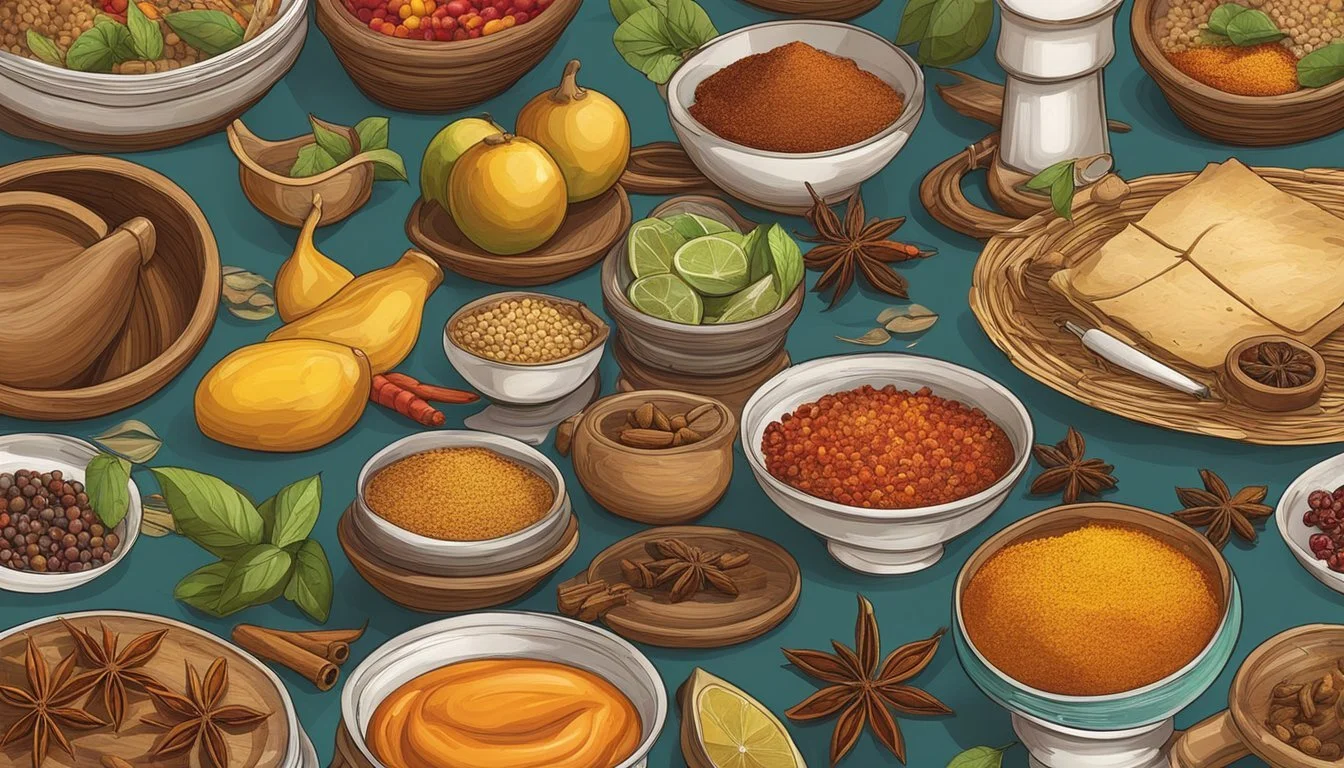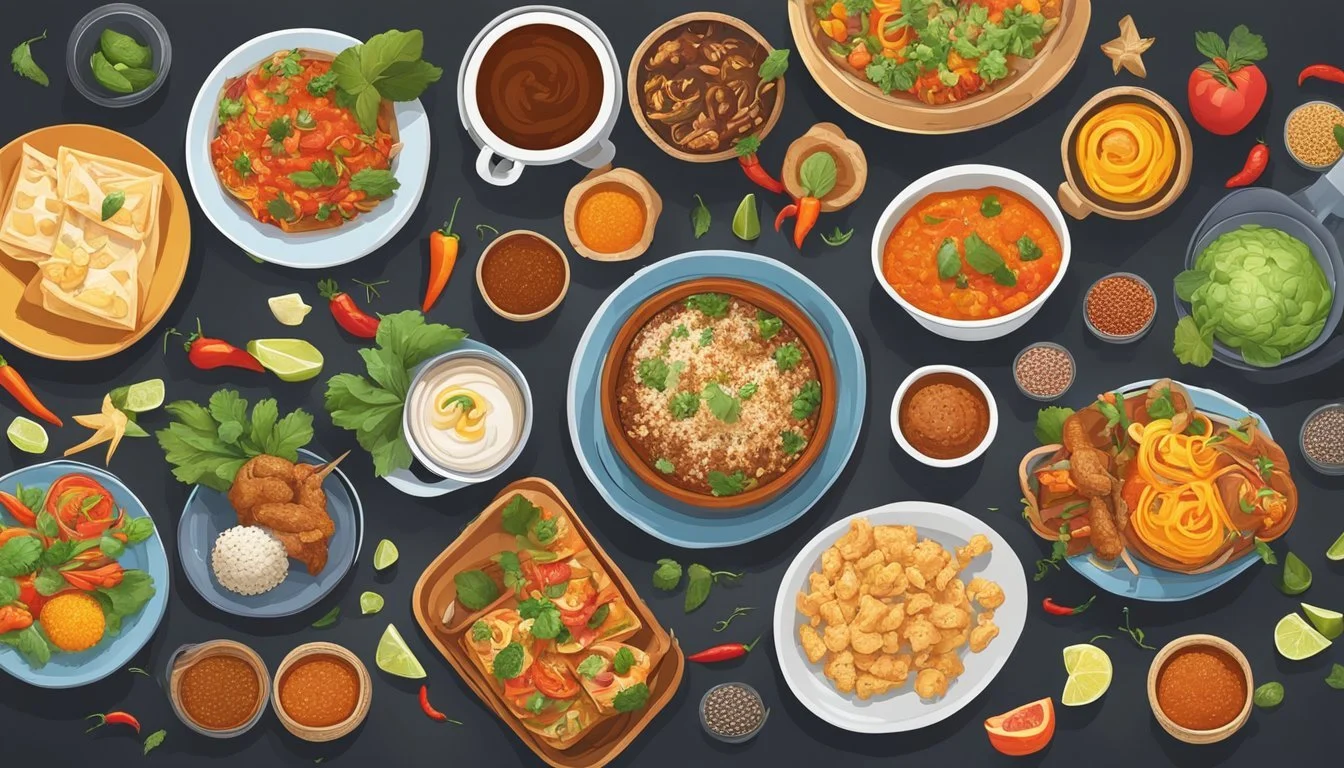Swicy Global Traditions
A Tour of World Cuisine's Sweet-Spicy Fusion
Fusing sweet and spicy flavors, a trend known as 'swicy,' has emerged as a culinary sensation worldwide, tantalizing tastebuds with its harmonious blend of seemingly opposing tastes. This combination is not new; cultures around the globe have long celebrated the dance of sugar and spice within their traditional dishes. Whether it's the heat of chillies cooled by a hint of mango in South Asia or the fiery tang of gingerbread in Europe, swicy flavors demonstrate a universal appeal that transcends borders and unites food enthusiasts.
By leveraging both the soothing properties of sweetness and the invigorating kick of spice, swicy dishes create a complex flavor profile renowned for stimulating the palate. This balance not only enhances the sensory experience of eating but also activates a physiological response. Spicy ingredients cause the body to release endorphins, which can contribute to a feeling of euphoria. Meanwhile, sweet components can temper the intensity of heat, offering a reprieve and highlighting the intricate layers of flavor.
The popularity of swicy foods is reflected in global gastronomy as chefs and home cooks alike elevate traditional recipes by incorporating innovative sweet-spicy combinations. From the smoky-sweet barbecue sauces of the American South to the sweet chili glazes popular in East Asian cuisine, the swicy concept adapts to local ingredients and culinary techniques, showcasing its versatility and enduring appeal in kitchens around the world.
The Rise of Swicy: A Flavor Evolution
Swicy, a blend of sweet and spicy flavors, is becoming increasingly popular in culinary experiences worldwide, as it caters to a dynamic range of taste preferences among consumers.
Historical Background of Sweet and Spicy
Sweet and spicy combinations have long been found in culinary traditions across the globe, each with its own distinct ingredients and cultural significances. For example, the use of hot honey in Italy or the spicy-sweet tamarind candies prevalent in Mexico demonstrate this blend's historical richness. These flavors balance each other, with sweetness often tempering the heat of spices to create a more complex and enjoyable taste experience.
Market Research and Consumer Demand
According to recent data from market research firm Datassential, sweet and spicy pairings, exemplified by the trend of 'swicy', have seen a remarkable 38% increase on menus in the past year. This notable rise reflects a growing consumer interest in complex flavor profiles. Industry analysis reveals that hot honey, and similar swicy condiments, are projected to continue growing in popularity, outpacing nearly all other culinary and beverage flavor trends. This surge is driven by consumer demand for new and unique tastes that also provide a sense of comfort and familiarity.
Cultural Significance and Global Impact
The harmonious blend of sweet and spicy elements in culinary traditions signifies a global palate that appreciates complexity and balance. This section explores the worldwide influence and cultural significance of these traditions, specifically through Korean, Mexican, and Szechuan cuisines.
Influence of Korean Cuisine
Korean cuisine is renowned for its bold flavors, where gochujang plays a critical role. This fermented chili paste conveys a unique sweet and spicy profile essential to many Korean dishes. Its use extends beyond Korea as a key ingredient in fusion cooking, influencing recipes worldwide and elevating simple dishes with its deep, piquant taste.
Key Ingredients:
Gochujang: Fermented blend of chili powder, glutinous rice, fermented soybeans, and salt.
Other Sweet-Spicy Elements: Often combined with sugar or honey to balance the heat.
Mexican Culinary Contributions
Mexican food (What wine goes well with Mexican food?) showcases a love for spice, with chili peppers and tajín—a seasoning made from chili peppers, lime, and salt—being staple elements. The cultural significance of such flavors is evident in the tradition of Mexican hot chocolate (What wine goes well with chocolate?) where cocoa and cinnamon intersect with a hint of spicy chili, thereby influencing the realm of sweet-spicy combinations.
Mexican Hot Chocolate Traditions:
Cocoa: The base of traditional Mexican hot chocolate.
Cinnamon: Adds aromatic warmth complementing the cocoa.
Chili Peppers: Provides a subtle heat.
Tajín: Sometimes used as a garnish for a tangy, spicy kick.
Szechuan: China's Fiery Gift
Szechuan cuisine, the pride of southwestern China, is distinguished by its liberal use of garlic, chili peppers, and the unique Szechuan peppercorn, which delivers a tingling spiciness. It characterizes China's culinary gift to the world—a thrilling sweet-spicy experience that leaves a memorable taste and has greatly influenced global dining preferences.
Example Dishes:
Kung Pao Chicken: Combines sweetness with the fiery taste of Szechuan peppercorns.
Mapo Tofu: Features a sauce enriched with both sweet and spicy elements.
The Science of Sweet and Spicy
Exploring the science of sweet and spicy reveals a complex interplay between the chemistry of heat and the body's response to it. Two pivotal concepts in this exploration are the Scoville Scale, which quantifies the spiciness of different peppers, and the role of endorphins in creating the pleasurable sensations often associated with spicy foods.
Scoville Scale: Measuring Heat
The Scoville Scale is the measurement of spiciness or piquancy in chili peppers through the detection of capsaicin content, the chemical compound responsible for the sensation of heat. This scale assigns a numerical value to a pepper variety known as Scoville Heat Units (SHU). For example:
Bell Peppers: 0 SHU
Jalapeño Peppers: 2,500–8,000 SHU
Habanero Peppers: 100,000–350,000 SHU
The scale ranges from zero, indicating no presence of capsaicin, up to millions for the fiercest peppers like the Carolina Reaper.
Endorphins and Pleasure Connection
When an individual consumes spicy food, the capsaicin in it binds to receptors in the mouth that are meant to detect heat, sending signals to the brain that mimic physical heat. The brain responds by releasing endorphins, natural opioids that function as painkillers and enhance a sense of wellbeing. It's this endorphin rush that contributes to the euphoria sometimes experienced during and after eating spicy dishes (What wine goes well with spicy dishes?). The sweet components in 'swicy' foods, meanwhile, can help to mitigate the intensity of the heat, offering a harmonious balance that appeals to the palate.
Iconic Swicy Foods and Recipes
The concept of blending sweet and spicy flavors is not novel, but its crescendo of popularity speaks to its indulgent balance of heat and sugar. This section explores renowned dishes and desserts that epitomize the swicy tradition, with a focus on specific, standout preparations.
Defining Swicy Dishes
Swicy dishes have made their mark around the globe, with various interpretations depending on local ingredients and cultural preferences. A prime example is the infusion of hot honey on classic pizza, imparting a tantalizing kick that complements the creamy cheese. Here is a brief table summarizing some of the iconic swicy dishes:
Dish Description Hot Honey Pizza A traditional pizza drizzled with spicy hot honey, creating a perfect balance between sweet and fiery tastes. Mango Salsa Often served with grilled fish or tacos, mango salsa combines ripe mangoes with spicy elements like jalapeño or cayenne pepper. Cowboy Candy Jalapeños are sliced and candied in a sugary syrup, eaten as a snack or a zesty garnish. Korean Fried Chicken Coated in a sweet and spicy sauce, this chicken has a crunchy exterior and a glaze that offers a punch of flavor. Tteokbokki Korean rice cakes bathed in a spicy and subtly sweet red chili sauce, mingling heat with a touch of sweetness.
Swicy Desserts Excellence
Swicy flavors are not confined to savory dishes; they can be artfully expressed in desserts, delivering a satisfying complexity and depth. Chocolate plays a critical role in swicy desserts, with its rich profile complementing the addition of spice. A few swicy dessert standouts include chocolate cakes laced with chili, adding a warm undertone that elevates the chocolate's natural bitterness. Similarly, popular snacks like Takis venture into the swicy territory, combining a sugary coating with a fierce spice level.
When it comes to cake, bakers are experimenting by accompanying traditional sweet flavors with zesty ingredients such as jalapeño or chipotle, crafting creations like Mango Chili Cake, where the fruit's sweetness is intensified by a chile-infused frosting.
Conclusively, both dishes and desserts that adopt swicy notes offer a culinary experience that is as invigorating as it is satisfying, with each bite marrying the bright zing of spice with the comforting blanket of sweetness.
Swicy in the Beverage Industry
The beverage industry has embraced the "swicy" trend, introducing a spectrum of sweet and spicy flavors into drinks, both alcoholic and non-alcoholic.
Sweet-Spicy Cocktails
Bartenders are crafting cocktails that balance the heat of spices with the richness of sweet elements. A popular example is the jalapeño margarita, which combines the zesty heat of jalapeño peppers with the sweet and sour profile of traditional margarita ingredients. This cocktail often features:
Tequila
Lime juice
Agave syrup
Muddled jalapeño slices
Another player in the swicy cocktail scene is mangonada, a Mexican-inspired slushy drink that merges sweet mango puree with spicy chili powder, often garnished with a tamarind straw.
Non-Alcoholic Beverage Trends
The non-alcoholic beverage sector is not far behind in incorporating swicy flavors. Brands like Torani and Monin have developed syrup lines catering to this trend. These syrups are used to add a sweet-spicy kick to a variety of drinks, including:
Sparkling waters
Iced teas
Lemonades
Coffee-based beverages
The versatility of these syrups highlights how swicy flavors can enhance traditional drinks and create new non-alcoholic beverage experiences.
Swicy on Social Media and Food Chains
The proliferation of 'Swicy'—the fusion of sweet and spicy flavors—has become a sensation on social media platforms like Instagram and TikTok, as well as on the menus of major food chains, reflecting a growing culinary trend that caters to adventurous palates.
The Role of Instagram and TikTok
Platforms such as Instagram and TikTok have been instrumental in popularizing 'Swicy' flavors. They serve as a canvas for food influencers and enthusiasts to showcase creative concoctions, providing visibility and virality to these taste combinations. TikTok, for instance, has highlighted the trend through viral videos that demonstrate the appeal of 'Swicy' foods, often leading to trends that are quickly picked up by mainstream audiences.
Swicy Menu Items at Major Restaurants
Several major food chains have incorporated 'Swicy' flavors into their menu items to capitalize on this growing trend. Here are some specifics:
Pizza Hut: Known for embracing innovative flavors, Pizza Hut has introduced menu items that exemplify the Swicy trend, such as a pizza topped with hot honey—a combination that epitomizes the sweet-spicy profile.
Chick-fil-A: Chick-fil-A has experimented with sauces that blend a sweet profile with a spicy kick, adding a new layer of flavor to their classic offerings.
Outback Steakhouse: At Outback Steakhouse, the addition of 'Swicy' elements can be found in signature dishes that pair bold spices with sweet glazes to elevate the dining experience.
Burger King: Burger King has also dabbled in 'Swicy' offerings, incorporating sweet-spicy sauces into some of their burgers and sides, thus attracting customers eager for new taste sensations.
Industry Perspectives on Swicy
The 'swicy' flavor trend, a fusion of sweet and spicy notes, has emerged as a culinary movement with strong industry endorsements. Renowned chefs and flavor innovators play pivotal roles in driving this trend into a global phenomenon.
Insights from Chefs and Food Experts
Chefs across various cuisines embrace the swicy trend, creatively incorporating it into their dishes. They note the intrinsic balance that a sweet-spicy mix brings to the table, enhancing both flavor profiles. The National Restaurant Association highlights 'swicy' as a top culinary trend for 2023, underlining its appeal among modern diners who seek complex and nuanced taste experiences.
Chef Andrea Ramirez, acclaimed for her expertise in blending traditional and modern flavors, exemplifies how chefs are at the forefront of this movement. She has been influential in popularizing 'swicy' through her innovative menu creations that intrigue food enthusiasts.
The Role of Flavor Innovators
Flavor innovators and companies are imperative in the wider adoption of swicy flavors. With data showing a 38% increase in sweet and spicy pairings on menus, the demand for novel flavor combinations escalates.
Organizations like T. Hasegawa express that consumer interest in global taste profiles has surged, with the swicy trend satisfying a curious palate that yearns for both sweetness and heat.
Publications such as the New York Times often spotlight these flavor trends, praising the role of flavor innovators in diversifying and enriching the culinary landscape, thus validating the swicy trend's significance and potential for staying power in the food industry.
The Future of Swicy: Predictions and Trends
The culinary landscape is perpetually evolving, with swicy flavors becoming a significant trend that entices consumers seeking pleasurable and unique eating experiences.
Emerging Sweet-Spicy Combinations
Market research indicates a continuous rise in the popularity of sweet-spicy, or 'swicy', flavors. According to Datassential, menu items featuring swicy flavors have increased by 38%, illustrating the growing consumer interest. As a result, the culinary world is set to witness a wave of innovative pairings that capitalize on this craving for contrasting yet complementary tastes. These combinations not only deliver a satisfying balance between heat and sweetness but also add depth to various dishes.
Rising swicy ingredients:
Hot Honey: A standout in the swicy category, hot honey is poised to see substantial growth, building on its recent momentum.
Spicy Maple: Maple syrup infused with chili peppers offers a nuanced twist to traditional sweetness.
Fruit and Chili Blends: Mango with chili, pineapple with jalapeño, and piquant berry compotes are examples of fruit-based swicy infusions.
Implications for Retail and Foodservice
The surge in swicy flavors has profound implications for retailers and foodservice providers. They must adapt to integrate these evolving consumer preferences into their product offerings. Retailers are expected to expand their range of swicy products, stocking sauces, snacks, and packaged goods that cater to the trend.
Retail Adjustments:
Broader swicy product selection across categories.
Marketing campaigns that highlight the swicy appeal.
In the foodservice sector, the inclusion of swicy items can serve as an effective strategy to attract and retain customers. Restaurant menus are predicted to feature an increasing number of swicy options, spanning appetizers to desserts, thereby granting diners a fuller experience of the sweet-spicy spectrum.
Foodservice Trends:
Expansion of swicy choices in menu development.
Training for culinary staff on balancing spiciness with appropriate levels of sweetness.
As indicated by industry insights, these trends are likely to continue ascending, signaling a future where swicy flavors maintain a strong presence in the global culinary traditions.
Swicy Glossary
This section provides clear definitions for terms associated with the rise of "swicy" flavors in global cuisine, a culinary trend that merges sweetness with spiciness to create unique taste experiences.
Key Terms and Definitions
Swicy: A portmanteau of "sweet" and "spicy," used to describe a flavor profile that combines elements of both taste sensations.
Portmanteau: A linguistic blend of words, in which parts of multiple words are combined to form a new word.
Datassential: A market research firm that tracks food trends and noted a significant increase in sweet and spicy pairings on menus, indicating their popularity, especially among younger generations such as Gen Z and millennials.
Sensory Experience: The overall sensation provided by the combination of sweet and spicy flavors, which can engage various neurological areas and tastebuds when consuming "swicy" foods.
Gen Z and Millennials: Demographic cohorts that have shown a preference for swicy flavors, influencing menu offerings and snack innovations like swicy-flavored Ruffles.
Spork: While not directly related to swicy, this is another example of a portmanteau, representing a hybrid utensil that combines elements of a spoon and a fork.
Ruffles: A brand of potato chips which, among other flavors, has introduced "swicy" flavored chips, showcasing the blend of sweetness and heat.
Xocolatl: The Nahuatl word for "bitter water," used historically to refer to a spicy chocolate drink that predates modern sweetened chocolate, offering an early example of a swicy flavor combination.
Szechuan Pepper: A spice originating from the Sichuan province of China, providing a numbing spiciness which is often paired with sweet elements in dishes.
Scoville Scale: A measure of the heat (or spiciness) of chili peppers or other spicy foods, which can be a crucial factor in balancing "swicy" flavors.
Habanero: A type of chili pepper with a high Scoville rating known for its fiery heat often paired with sweet flavors in sauces and condiments to create a swicy taste profile.
Conclusion
The emergence of swicy flavors in global culinary traditions speaks to a universal appeal for dishes that harmonize contrasting tastes. Swicy foods have been embraced by various cultures, each adding its unique signature to this delicious dichotomy. The trend has gained momentum, solidifying its place in contemporary cuisine with a 38% increase in menu appearances over the past year.
Key Takeaways:
Swicy flavors represent a dance between sweetness and heat, enhancing dishes with a complex, satisfying profile.
The physiological reaction to spiciness and the tempering effect of sweet ingredients create a coveted endorphin release, adding to the appeal of swicy foods.
Rebranding traditional flavors under the swicy umbrella has fortified the trend's position in the culinary scene, with hot honey and other swicy condiments leading the charge.
The swicy culinary trend showcases the innovative spirit of chefs and the evolving palate of diners. One finds cultural commonality through a shared appreciation for food that excites and comforts, a testament to culinary diversity and the power of flavor fusion.










